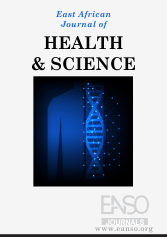Hygiene and Safety Measures Practised by Roadside Meat Vendors of Namawojjolo and Lukaya Food Markets, Uganda
Abstract
Handling and preparation of roadside roasted meats may often be compromised, considering the general conditions of the makeshift structures and the common minimal education levels of vendors. The study’s objectives were to assess hygiene and safety practices applied in handling, preparing, and vending of roadside roasted meats. Conducted in October 2024 at Namawojjolo and Lukaya, two major food markets along central Uganda's busiest highways, the research used an observational checklist and questionnaires to collect data from 90 meat vendors selling roasted beef, chicken, or goat meat on compliance with best known practices. Descriptive results on hygienic and handling practices were generated, and scores above 70% were used as a hallmark for best practice. Only 6.7% instituted complete sanitation and hygienic practices, while 88.9% did not store leftover meat in refrigerators. Among them, 67.8% kept meat in clean containers, 5.6% stored utensils on clean shelves, and 6.7% had clean roasting areas. Most (93.3%) separate raw meat from ready-to-eat meat, and 37.8% had stalls without rodents. Hygienically, 75.6% wore aprons while working, among whom 85.3% were considered clean aprons, 46.7% had hair covered, 91.1% had short and clean fingernails, 93.3% washed hands with soap, 1.1% covered food while presenting to customers, and 11.1% wore jewellery while working. Training on food safety was undertaken by 63.3% and 78.9% served food in paper bags. Personal hygiene practices of most vendors were fairly good, but most lacked sanitation facilities and demonstrated relatively low knowledge of best and acceptable practices in meat handling. There is a need for more sensitisation and provision of sanitation facilities to vendors to improve both the quality and safety of roadside vendor products
Downloads
References
Bagumire, A., & Karumuna, R. (2017). Bacterial contamination of ready-to-eat meats vended in highway markets in Uganda. African Journal of Food Science, 11(6), 160-170.
Bagumire, A., & Karumuna, R. (2019). Sanitation facilities and practices for street-vended meats at two major highway markets in Uganda. African Journal of Food, Agriculture, Nutrition and Development, 19(2), 14337-14353.
Bagumire, A., & Rollanda, K. (2017). Hygiene facilities and practices for vended meats at selected highway markets in Uganda. Journal of Food and Nutrition Sciences, 5(1), 1-10.
Baidya, S., & Rahman, T. (2021). A Review on the prevalence and Detection of Bacterial contamination in Common Food and Associated Health Risk Brac University].
Bhalla, T. C. (2019). International laws and food-borne illness. In Food Safety and Human Health (pp. 319-371). Elsevier.
Chukuezi, C. O. (2010). Food safety and hyienic practices of street food vendors in Owerri, Nigeria. Studies in sociology of science, 1(1), 50.
Hoffmann, S., Devleesschauwer, B., Aspinall, W., Cooke, R., Corrigan, T., Havelaar, A., Angulo, F., Gibb, H., Kirk, M., & Lake, R. (2017). Attribution of global foodborne disease to specific foods: Findings from a World Health Organization structured expert elicitation. PloS one, 12(9), e0183641.
Jaffee, S., Henson, S., Unnevehr, L., Grace, D., & Cassou, E. (2018). The safe food imperative: Accelerating progress in low-and middle-income countries. World Bank Publications.
Kish- Leslie. (1965). Sampling organizations and groups of unequal sizes. American Sociological Review, 564-572.
Kungu, J. M., Ejobi, F., Atuheire, C., Baluka, S., Kiganira, D. B., Namyalo, E., Meeme, R., & Okuyo, B. A. (2021). Assessment of Compliance to Animal Source Foods Quality and Safety Standards in Uganda. A Case of Kampala and Mbarara Districts.
Letuka, P. O., Nkhebenyane, J., & Thekisoe, O. (2021). Street food handlers' food safety knowledge, attitudes and self-reported practices and consumers' perceptions about street food vending in Maseru, Lesotho. British Food Journal, 123(13), 302-316.
Momtaz, M., Bubli, S. Y., & Khan, M. S. (2023). Mechanisms and health aspects of food adulteration: A comprehensive review. Foods, 12(1), 199.
Mugagga, H. (2021, January 05, 2021). How safe is the meat we eat? Daily Monitor Uganda. https://www.monitor.co.ug/uganda/lifestyle/reviews-profiles/how-safe-is-the-meat-we-eat--1672864
Oloo, N. S., & Wakhungu, J. W. (2019a). Level of knowledge of street and highway food vendors and consumers on basic food handling principles in Kampala and Kisumu cities, East Africa. Multidisciplinary Research Academic Journal (MDRAJ), Vol 4. (Issue 2).
Oloo, N. S., & Wakhungu, J. W. (2019b). Level of knowledge of street and highway food vendors and consumers on basic food handling principles in Kampala and Kisumu cities, East Africa. Multidisciplinary Research Academic Journal (MDRAJ), 4(2), 1-13.
Rohith, S. (2021). An investigation into the hygiene practices and food safety of street vendors outside pension pay-out points in urban poor communities in the City of Cape Town Stellenbosch: Stellenbosch University].
Soon, J. M. (2019). Rapid Food Hygiene Inspection Tool (RFHiT) to assess hygiene conformance index (CI) of street food vendors. LWT, 113, 108304.
Tumuhe, C. L., Kusiima, J., Sekamate, W., & Mulumba, M. (2020). Food Staffs Available on Market Stalls and Restaurants in Rural Urban Centers; a Case of Kagadi Town, Uganda. Journal of Food Security, 8(1), 29-37.
Uçar, A., Yilmaz, M. V., & Çakiroglu, F. P. (2016). Food safety–problems and solutions. Significance, prevention and control of food related diseases, 3.
Copyright (c) 2025 Annet Nanfuka, Eunice Akello Mewa, Harold Anindo Rachuonyo

This work is licensed under a Creative Commons Attribution 4.0 International License.




























